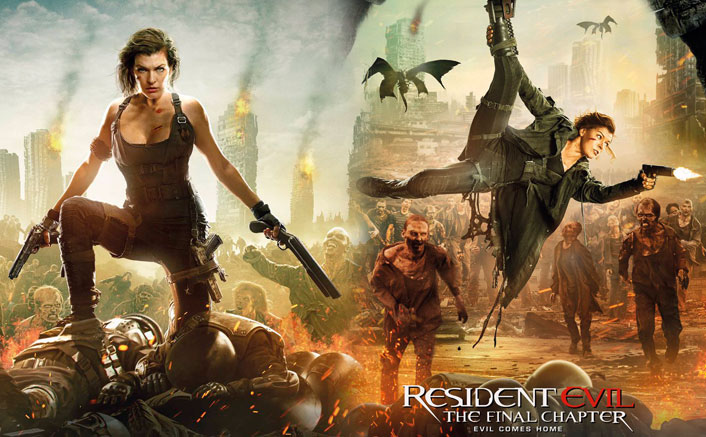Star cast: Milla Jovovich, Ali Larter, Wentworth Miller
Plot: In a world ravaged by a virus infection, turning its victims into the Undead, Milla Jovovich continues on her journey to find survivors and lead them to safety, even after she loses her superhuman powers. Her deadly battle with the Umbrella Corporation reaches new heights, but Jovovich gets some unexpected help from an old friend, Ali Larter. A new lead that promises a safe haven takes them to Los Angeles, but when they arrive, the city is overrun by thousands of Undead. Jovovich and her comrades fight their way through it.
What’s Good: The well-shot action sequences; Mila Jovovich’s attitude and acting.
What’s Bad: The non-existent storyline; the uselessness of 3D for such a film; the absence of emotions.
Verdict: Resident Evil: Afterlife makes for an average watch. Fans of the franchise, of which this is the fourth film, will be disappointed. It proves that you can’t stretch a movie franchise for eternity, especially in the absence of a good script.
Loo Break: Several; you won’t miss much.
Resident Evil: Afterlife starts with a wonderful slow-motion sequence of an innocent girl standing in the middle of a crossroad in Japan; the rain droplets all around her, people walking past her – all this in aesthetically shot three dimensional images. Suddenly, the girl pounces upon a passerby and bites him, as the audience zooms out of the city, and the lights go out as the virus spreads throughout the city and beyond. A voice over, in first person, informs us that Alice (Milla Jovovich) is fighting against the evil Umbrella Corporation, which is behind the virus that has spread across the world, turning human beings into the Undead – zombies who will feast on human flesh and blood. The film begins when Alice lands up in Umbrella Corporation’s underground headquarters in Japan, all ready to kill at will and seek revenge.
Even though Alice manages to destroy the headquarters, the corporation boss, Albert Wesker (Shawn Roberts) escapes. But not before he injects her with an antidote to the T-virus – that had given Alice her superhuman strength and agility – in effect, making her human again. Alice, apparently happy to be human again, flies cross country to Alaska in a rickety airplane, in search for Arcadia, a land free of viruses. Once in Alaska, she finds, an amnesiac Claire Redfield (Ali Larter) and both of them fly to Los Angeles, a city in ruins and full of the Undead. Here, Alice meets a bunch of survivors, holding up inside a jail, and together, they put up a brave attempt at reaching the fabled land of Arcadia, with the Undead and the Umbrella Corporation to fight against. Do they find Arcadia? Are Albert Wesker and his evil designs defeated? The rest of the film answers these questions.
Unlike the previous three editions of the Resident Evil franchise (Resident Evil, Resident Evil: Apocalypse and Resident Evil: Extinction), this one falls short on the storyline. The script (Paul W.S. Anderson) is based on a flimsy premise, not unlike the numerous zombie-apocalypse movies made in Hollywood every year. There are several logical inconsistencies that stand out, even if you accept that the film is a science-fiction fantasy. Suddenly, devoid of her superhuman powers and the ability to recuperate, Alice is nevertheless portrayed as a very effective killer, never falling victim to the stray bullet. Also unexplained is the mystery behind why Chris Redfield (Wentworth Miller) is held captive in spite of being in possession of valuable information. The whole idea is forced.
As far as the actors’ performances are concerned, Milla Jovovich is very good as Alice, but is limited by the script. She performs ably in the action sequences and looks quite a fighter! The rest of the cast is miserable, except for Ali Larter, who complements Milla in a wonderfully choreographed action sequence.
Paul W.S. Anderson, who had also directed the 2002 original, Resident Evil, makes a botched attempt at entertaining the audience. Stylish action sequences, explosions and gunfights apart, the film fails to hold the viewers’ attention. Even the fact that the film is in 3D is less of an advantage and more of a latent headache! What you lose in the story, you can’t gain in 3D. However, there is a lot for the audience which is interested in no-holds-barred action. The special and visual effects are excellent. In fact, one wonders what the film would have been like, had the story been more interesting. Glen MacPherson’s cinematography is good. Editing (by Niven Howie) is okay.
All in all, Resident Evil: Afterlife disappoints despite all the bells and whistles. Although interesting in parts, especially the action sequences, the film fails to live up to the franchise brand.



 Follow Us
Follow Us








